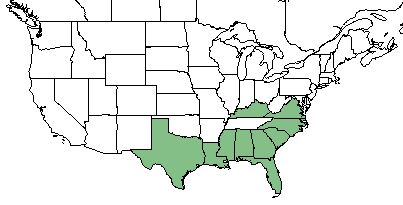Difference between revisions of "Muhlenbergia expansa"
(→Habitat) |
|||
| Line 1: | Line 1: | ||
{{italic title}} | {{italic title}} | ||
| + | Common names: cutover muhly <ref name= "USDA"> [https://plants.usda.gov/core/profile?symbol=CEAM USDA Plant Database]</ref>, wiregrass <ref name="garren">Garren, K. H. (1943). "Effects of fire on vegetation of the southeastern United States." Botanical Review 9(9): 617-654.</ref> | ||
<!-- Get the taxonomy information from the NRCS Plants database --> | <!-- Get the taxonomy information from the NRCS Plants database --> | ||
{{taxobox | {{taxobox | ||
| Line 32: | Line 33: | ||
===Habitat=== | ===Habitat=== | ||
Fine textured soils, and strongly acid sands are part of the ideal habitat for ''M. expansa'' <ref name= "USDA"> [https://plants.usda.gov/core/profile?symbol=CEAM USDA Plant Database]</ref> In general, pine savannas, pine flatwoods, and mesic areas in sandhill-pocosin ecotones are the environments where ''M. expansa'' can be found. <ref name= "Weakley"> Weakley, A. S. (2015). Flora of the Southern and Mid-Atlantic States. Chapel Hill, NC, University of North Carolina Herbarium.</ref> | Fine textured soils, and strongly acid sands are part of the ideal habitat for ''M. expansa'' <ref name= "USDA"> [https://plants.usda.gov/core/profile?symbol=CEAM USDA Plant Database]</ref> In general, pine savannas, pine flatwoods, and mesic areas in sandhill-pocosin ecotones are the environments where ''M. expansa'' can be found. <ref name= "Weakley"> Weakley, A. S. (2015). Flora of the Southern and Mid-Atlantic States. Chapel Hill, NC, University of North Carolina Herbarium.</ref> | ||
| + | |||
| + | ''M. expansa'' has been determined as an indicator species for the Henslow's Sparrows habitats in southeastern Louisiana, it is one of the preferred seeds of the sparrow. <ref name= "dimiceli">DiMiceli, J. K., et al. (2007). "Seed preferences of wintering Henslow's sparrows." Condor 109: 595-604.</ref> | ||
<!--Natural communities, human disturbed habitats, topography, hydrology, soils, light, fire regime requirements for removal of competition, etc.--> | <!--Natural communities, human disturbed habitats, topography, hydrology, soils, light, fire regime requirements for removal of competition, etc.--> | ||
Revision as of 20:26, 14 June 2018
Common names: cutover muhly [1], wiregrass [2]
| Muhlenbergia expansa | |
|---|---|
Error creating thumbnail: Unable to save thumbnail to destination
| |
| Photo by Bobby Hattaway at Discoverlife.org | |
| Scientific classification | |
| Kingdom: | Plantae |
| Division: | Magnoliophyta - Flowering plants |
| Class: | Liliopsida - Moncots |
| Order: | Poales |
| Family: | Poaceae |
| Genus: | Muhlenbergia |
| Species: | M. expansa |
| Binomial name | |
| Muhlenbergia expansa Poir. | |

| |
| Natural range of Muhlenbergia expansa from USDA NRCS Plants Database. | |
Contents
Taxonomic Notes
Synonym: M. capillaris
Variety: none
Description
M. expansa is a perennial graminoid of the Poaceae family that is native to North America. [1]
Distribution
The southeastern region of the United States is the native range of M. expansa; specifically in FLorida, Georgia, South Carolina, North Carolina, Virginia, Kentucky, Alabama, Mississippi, Louisiana, and Texas. [1]
Ecology
Habitat
Fine textured soils, and strongly acid sands are part of the ideal habitat for M. expansa [1] In general, pine savannas, pine flatwoods, and mesic areas in sandhill-pocosin ecotones are the environments where M. expansa can be found. [3]
M. expansa has been determined as an indicator species for the Henslow's Sparrows habitats in southeastern Louisiana, it is one of the preferred seeds of the sparrow. [4]
Phenology
April is the common month where much of the growth happens for M. expansa. Seeds are produced during the late summer months that can be dispersed throughout the following year. [1]
Fire ecology
Burning is a successful solution to managing the grass. [1]
Use by animals
Animals use the grass for forage but is not used as a food source for any animal apart from some livestock but even then it is not their entire food source. [1]
Conservation and Management
Cultivation and restoration
Photo Gallery
References and notes
- ↑ 1.0 1.1 1.2 1.3 1.4 1.5 1.6 USDA Plant Database
- ↑ Garren, K. H. (1943). "Effects of fire on vegetation of the southeastern United States." Botanical Review 9(9): 617-654.
- ↑ Weakley, A. S. (2015). Flora of the Southern and Mid-Atlantic States. Chapel Hill, NC, University of North Carolina Herbarium.
- ↑ DiMiceli, J. K., et al. (2007). "Seed preferences of wintering Henslow's sparrows." Condor 109: 595-604.